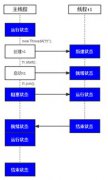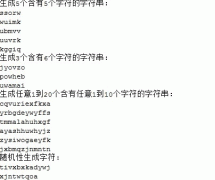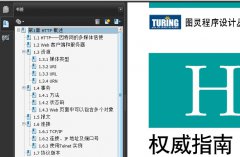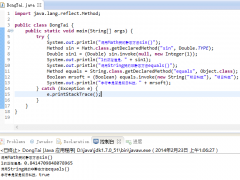Java多线程及其同步实现原理
一. 实现多线程
1. 虚假的多线程
例1:
public class TestThread
{
int i=0, j=0;
public void go(int flag)
{
while(true)
{
try{ Thread.sleep(100);
}
catch(InterruptedException e)
{
System.out.println("Interrupted");
}
if(flag==0) i++;
System.out.println("i=" + i);
}
else
{
j++;
System.out.println("j=" + j);
}
}
}
public static void main(String[] args)
{
new TestThread().go(0);
new TestThread().go(1);
}
}
上面程序的运行结果为:
i=1
i=2
i=3
。。。
结果将一直打印出I的值。我们的意图是当在while循环中调用sleep()时,另一个线程就将起动,打印出j的值,但结果却并不是这样。关于sleep()为什么不会出现我们预想的结果,在下面将讲到。
2. 实现多线程
通过继续class Thread或实现Runnable接口,我们可以实现多线程
2.1 通过继续class Thread实现多线程
class Thread中有两个最重要的函数run()和start()。
1) run()函数必须进行覆写,把要在多个线程中并行处理的代码放到这个函数中。
2) 虽然run()函数实现了多个线程的并行处理,但我们不能直接调用run()函数,而是通过调用start()函数来调用run()函数。在调用start()的时候,start()函数会首先进行与多线程相关的初始化(这也是为什么不能直接调用run()函数的原因),然后再调用run()函数。
例2:
public class TestThread extends Thread
{
private static int threadCount = 0;
private int threadNum = ++threadCount;
private int i = 5;
public void run()
{
while(true)
{
try
{
Thread.sleep(100);
}
catch(InterruptedException e)
{
System.out.println("Interrupted");
}
System.out.println("Thread " + threadNum + " = " + i);
if(--i==0) return;
}
}
public static void main(String[] args)
{
for(int i=0; i<5; i++)
new TestThread().start();
}
}
运行结果为:
Thread 1 = 5
Thread 2 = 5
Thread 3 = 5
Thread 4 = 5
Thread 5 = 5
Thread 1 = 4
Thread 2 = 4
Thread 3 = 4
Thread 4 = 4
Thread 1 = 3
Thread 2 = 3
Thread 5 = 4
Thread 3 = 3
Thread 4 = 3
Thread 1 = 2
Thread 2 = 2
Thread 5 = 3
Thread 3 = 2
Thread 4 = 2
Thread 1 = 1
Thread 2 = 1
Thread 5 = 2
Thread 3 = 1
Thread 4 = 1
Thread 5 = 1
从结果可见,例2能实现多线程的并行处理。
**:在上面的例子中,我们只用new产生Thread对象,并没有用reference来记录所产生的Thread对象。根据垃圾回收机制,当一个对象没有被reference引用时,它将被回收。但是垃圾回收机制对Thread对象“不成立”。因为每一个Thread都会进行注册动作,所以即使我们在产生Thread对象时没有指定一个reference指向这个对象,实际上也会在某个地方有个指向该对象的reference,所以垃圾回收器无法回收它们。
3) 通过Thread的子类产生的线程对象是不同对象的线程
class TestSynchronized extends Thread
{
public TestSynchronized(String name)
{
super(name);
}
public synchronized static void prt()
{
for(int i=10; i<20; i++)
{
System.out.println(Thread.currentThread().getName() + " : " + i);
try
{
Thread.sleep(100);
}
catch(InterruptedException e)
{
System.out.println("Interrupted");
}
}
}
public synchronized void run()
{
for(int i=0; i<3; i++)
{
System.out.println(Thread.currentThread().getName() + " : " + i);
try
{
Thread.sleep(100);
}
catch(InterruptedException e)
{
System.out.println("Interrupted");
}
}
}
}
public class TestThread
{
public static void main(String[] args)
{
TestSynchronized t1 = new TestSynchronized("t1");
TestSynchronized t2 = new TestSynchronized("t2");
t1.start();
t1.start(); //(1)
//t2.start(); (2) }}
- 上一篇:Java多线程编程经验谈
- 下一篇:java api 接口篇(二)下





